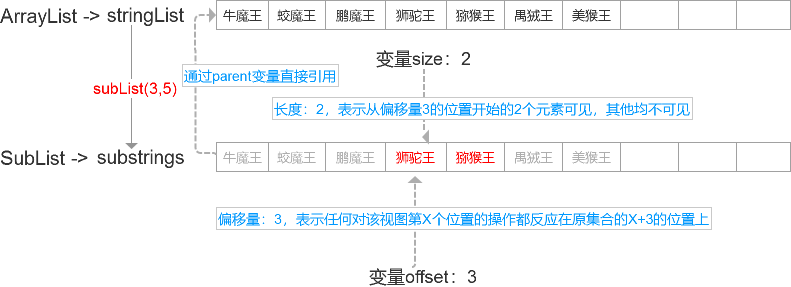上一章说了,但还有一块儿内容没说到,那就是subList方法。先看一段代码
public static void testSubList() { List stringList = new ArrayList<>(); stringList.add("牛魔王"); stringList.add("蛟魔王"); stringList.add("鹏魔王"); stringList.add("狮驼王"); stringList.add("猕猴王"); stringList.add("禺贼王"); stringList.add("美猴王"); List substrings = stringList.subList(3,5); System.out.println(substrings.toString()); System.out.println(substrings.size()); substrings.set(1, "猪八戒"); System.out.println(substrings.toString()); System.out.println(stringList.toString());} 看看执行结果如何?
[狮驼王, 猕猴王]2[狮驼王, 猪八戒][牛魔王, 蛟魔王, 鹏魔王, 狮驼王, 猪八戒, 禺贼王, 美猴王]
第一和第二的执行结果,非常容易理解,subList()方法作用就是截取集合stringList中一个范围内的元素。
第三和第四的执行结果都值得分析了,首先截取的字符串集合值为 [狮驼王, 猕猴王] ,但因为猕猴王在大雷音寺被美猴王打死了,我们用猪八戒来代替猕猴王;
因此我们通过substrings.set(1, "猪八戒"),将这个集合中第二个位置的值“猕猴王”设置为“猪八戒”,最终打印出来的结果也正是我们所预期的;但同时我们打印原集合stringList,发现其中的“猕猴王”也变成了“猪八戒”。这就比较奇怪了,两个问题:
1.我们操作的是截取后的集合,为什么原集合会变?
2.我们设置截取后某个位置(如第2个位置)的值,原集合改变的却不是对应位置的值?
一. subList原理初探
接下来我们带着问题寻找答案,我们看一下subList()的源码
/** * Returns a view of the portion of this list between the specified * {@code fromIndex}, inclusive, and {@code toIndex}, exclusive. (If * {@code fromIndex} and {@code toIndex} are equal, the returned list is * empty.) The returned list is backed by this list, so non-structural * changes in the returned list are reflected in this list, and vice-versa. * The returned list supports all of the optional list operations. * * This method eliminates the need for explicit range operations (of * the sort that commonly exist for arrays). Any operation that expects * a list can be used as a range operation by passing a subList view * instead of a whole list. For example, the following idiom * removes a range of elements from a list: *
* list.subList(from, to).clear(); *
* Similar idioms may be constructed for {@link #indexOf(Object)} and * {@link #lastIndexOf(Object)}, and all of the algorithms in the * {@link Collections} class can be applied to a subList. * * The semantics of the list returned by this method become undefined if * the backing list (i.e., this list) is structurally modified in * any way other than via the returned list. (Structural modifications are * those that change the size of this list, or otherwise perturb it in such * a fashion that iterations in progress may yield incorrect results.) * * @throws IndexOutOfBoundsException {@inheritDoc} * @throws IllegalArgumentException {@inheritDoc} */public List
subList(int fromIndex, int toIndex) { subListRangeCheck(fromIndex, toIndex, size); return new SubList(this, 0, fromIndex, toIndex);} 看注释,大概有以下几个意思
- 返回的是原集合在fromIndex和toIndex之间的元素的视图,虽然为视图,但支持集合的所有方法;
- 当fromIndex和toIndex相同时,返回空的视图;
- 任何对截取的视图的操作都会被原集合所取代;
看注释仅能知道我们例子最后的运行结果是正常的,但是对原理也还并不是特别清楚。我们继续看源码。
首先我们在例子中调用subList(3, 5)时,是new了一个SubList,这个SubList是ArrayList内部类,继承了AbstractList
private class SubList extends AbstractListimplements RandomAccess { private final AbstractList parent; private final int parentOffset; private final int offset; int size; SubList(AbstractList parent, int offset, int fromIndex, int toIndex) { this.parent = parent; this.parentOffset = fromIndex; this.offset = offset + fromIndex; this.size = toIndex - fromIndex; this.modCount = ArrayList.this.modCount; }}
从这个内部类的源码中,我们可以看到:
- SubList并没有像ArrayList一样定义Object[]来存放数据,而定义了一个变量parent来保存传递的原集合;
- 定义了一个offset用于保存进行偏移量,当对SubList修改时,就可以通过偏移量找到parent中对应的位置;
- 定义了size用来表示我们在parent集合中可见范围是多少;

有了上面的说明,其实SubList的原理已经很清晰了,接下来,我们用SubList中常用的方法来印证一下。
二. add(E e)方法
substrings.add("九头蛇");System.out.println(substrings.toString());System.out.println(stringList.toString()); 接着上面的例子,在substrings中添加“九头蛇”,按照规则,add()方法添加元素会在集合的最后,也就是说substrings的第3个位置(下标为2),对应parent原集合的位置下标就是2+3=5,会在stringList第六个位置插入“九头蛇”。看一下输出的结果
[狮驼王, 猪八戒, 九头蛇][牛魔王, 蛟魔王, 鹏魔王, 狮驼王, 猪八戒, 九头蛇, 禺贼王, 美猴王]
可以看到结果的确如此,那么我们在看一下add(E e),在SubList这个内部类里面并没有发现该方法,因此我去父类中找。
在AbstractList中找到了
public boolean add(E e) { add(size(), e); return true;} 接下来,我们在SubList中找到了实现方法
public void add(int index, E e) { rangeCheckForAdd(index); checkForComodification(); parent.add(parentOffset + index, e); this.modCount = parent.modCount; this.size++;} 很明显,源代码和我们开始的分析是一致的,当然在添加之间需要进行空间容量判断,是否足以添加新的元素,扩容规则,我们上一章已经讲过。
三. 其他方法
关于SubList的其他方法,其实和add原理一样,不论是set(int index, E e),get(int index),addAll(Collection<? extends E> c),remove(int index),都是先判断当前传入的位置索引是否正确(如是否大于size,小于0等),再根据规则计算出原集合中的位置下标,最终完成对集合的操作。
四. 总结
本文续接上一章ArrayList原理及使用,对ArrayList中的常用方法subList进行了剖析,从源码的角度对通过subList方法得到的集合和原集合有何关系,有何不同点,从而避免工作中遇到各种坑,若有不对之处,请批评指正,望共同进步,谢谢!